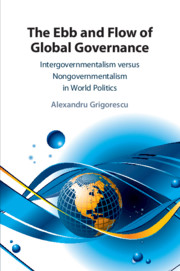 The Ebb and Flow of Global Governance
The Ebb and Flow of Global Governance Book contents
- The Ebb and Flow of Global Governance
- The Ebb and Flow of Global Governance
- Copyright page
- Contents
- Figures
- Tables
- Acknowledgments
- Acronyms
- 1 The Intergovernmental–Nongovernmental Continuum in Global Governance
- 2 Causes of Intergovernmentalism and Nongovernmentalism
- 3 Global Governance in the Health Realm
- 4 Global Governance in the Labor Realm
- 5 Global Governance in the Technical Standards Realm
- 6 Conclusions
- References
- Index
1 - The Intergovernmental–Nongovernmental Continuum in Global Governance
Published online by Cambridge University Press: 17 March 2020
- The Ebb and Flow of Global Governance
- The Ebb and Flow of Global Governance
- Copyright page
- Contents
- Figures
- Tables
- Acknowledgments
- Acronyms
- 1 The Intergovernmental–Nongovernmental Continuum in Global Governance
- 2 Causes of Intergovernmentalism and Nongovernmentalism
- 3 Global Governance in the Health Realm
- 4 Global Governance in the Labor Realm
- 5 Global Governance in the Technical Standards Realm
- 6 Conclusions
- References
- Index
Summary
Despite the lack of a global government, many important global problems have been tackled by national governments, usually acting together through intergovernmental organizations (IGOs) such as the United Nations (UN), the Organization of American States (OAS), and the International Monetary Fund (IMF), and by nongovernmental actors such as Amnesty International, the World Federation of Trade Unions, and the Bill & Melinda Gates Foundation. The actions taken by such organizations to resolve global problems have been referred to as forms of “global governance.” In almost all of the global governance literature, it is assumed that the distinction between intergovernmental and nongovernmental actors is clear-cut, consequential, and self-evident.
- Type
- Chapter
- Information
- The Ebb and Flow of Global GovernanceIntergovernmentalism versus Nongovernmentalism in World Politics, pp. 1 - 28Publisher: Cambridge University PressPrint publication year: 2020
